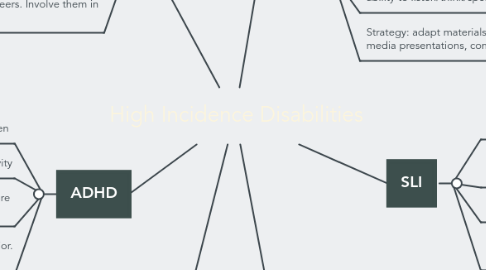High Incidence Disabilities
S Bにより

1. ID
1.1. have an IQ 70 or lower
1.2. have to be taught adaptive behaviors/intellectual functions
1.3. originates before 18 years old
1.4. Strategy: provide students with the same materials as peers. Involve them in daily activities. Pre-teach the daily routine if needed.
2. EBD
2.1. boys 3.5 times more likely to be diagnosed
2.2. affects social behavior, academics, may have affective disorders
2.3. they may have internalizing or externalizing behaviors
2.4. Strategy: use behavior contracts with students with EBDs. They are individually negotiated contracts between the teacher and the student.
3. ADHD
3.1. 3-7% of all school age children
3.2. inattention, hyperactivity, impulsivity
3.3. symptoms are present for at least 6 months, appear before age 12, in at least 2 settings
3.4. Strategy: teach the student to self-monitor for on-task behavior. Give the student rewards for how well he monitored himself
4. SLI
4.1. affects speech, such as, voice, articulation, fluency
4.2. affects language, such as, expressive, receptive, aphasia
4.3. is the second most common HI
4.4. Strategy: seat students with SLI's near the front of the classroom for easier listening for them and for easier access if they need help
5. SLD
5.1. most common HI - males are 2 times more likely to have SLD
5.2. identified by IQ Achievement Discrepancy Model or RTI
5.3. one or more of the basic psychological processes used to understand or use spoken or written language is manifested in an imperfect ability to listen/think/speak/read/write/spell/do math calculations
5.4. Strategy: adapt materials to reduce literacy requirements; use hands on activities, media presentations, computer simulations, or partner reading just to name a few
6. ASD
6.1. 1 in 54 children in the US diagnosed (2020)
6.2. 4/5 times more boys diagnosed
6.3. it affects: social interactions, language (like non literal language), behavior
6.4. Strategy: ASD students need to have a predictable environment. Write the class schedule on the board each day and stick to it.


